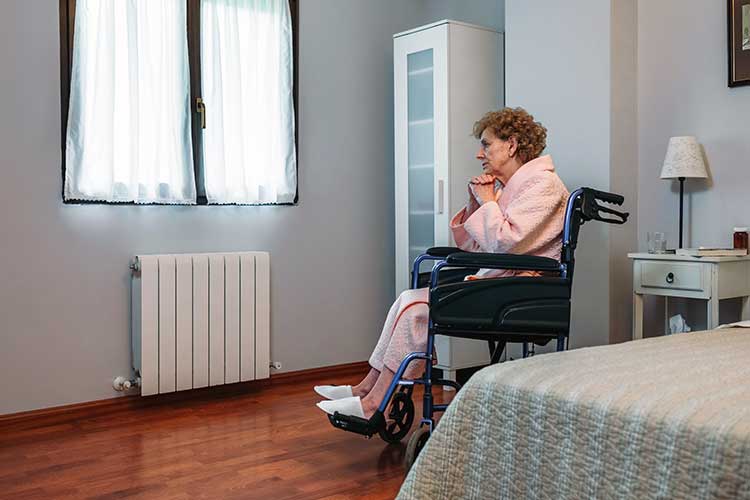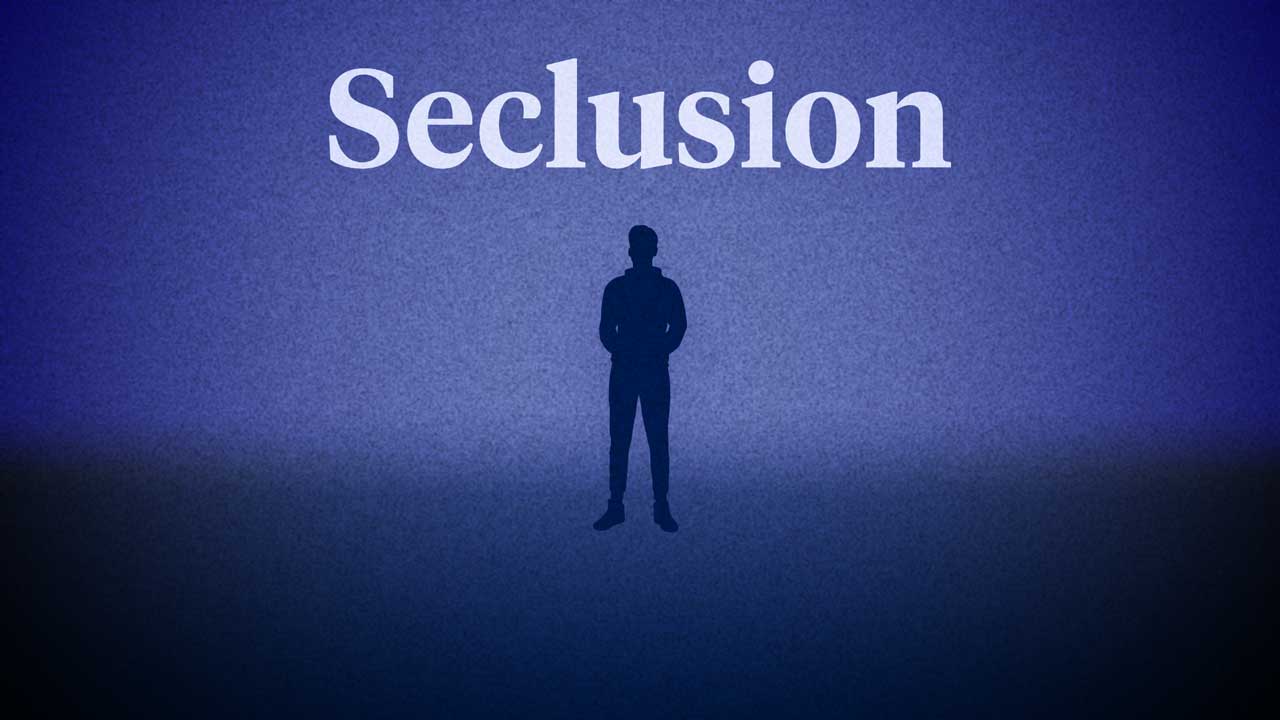What is Seclusion?
Seclusion is when a client is confined in a room or a physical space alone at any time of day or night and prevented from freely exiting (or it’s implied that they cannot freely exit), for the purpose of influencing their behaviour (ACQSC 2021).
Examples of seclusion include locking a client in a room, or removing their access to a mobility aid (ACQSC 2021).
Seclusion is a type of restrictive practice. Restrictive practices are potentially harmful and must only be used as a last resort intervention, in their least restrictive form (ACQSC 2021).
In 2021-2022, there were 10,851 seclusion events recorded in acute hospitals in Australia, lasting for an average of six hours each (AIHW 2023).
Seclusion in the National Safety and Quality Health Service Standards
Seclusion is outlined in Action 5.36 of the National Safety and Quality Health Service Standards, under Standard 5: Comprehensive Care.
This action aims to minimise the use of seclusion in healthcare, and consequently, the harm incurred by clients. Providers are required to meet the following guidelines:
- The use of seclusion is minimised and eliminated if possible
- Seclusion is used in accordance to legislation
- Any use of seclusion is reported to the governing body.
(ACSQHC 2015)
Requirements for the Use of Seclusion
In some circumstances, the use of restrictive practices may be necessary. In these situations, restrictive practices must only be used as a last resort, in the least restrictive form, and, for the shortest amount of time (Health.vic 2021).
Healthcare services must meet the following strict requirements in order for seclusion to be used lawfully:
- Seclusion must only be used as a last resort in preventing harm to the client or others, after considering the likely effect on the client.
- An approved health practitioner or an authorised psychiatrist who has ongoing knowledge of the client must assess them as posing a risk of harm to themselves or others, assess seclusion as necessary, and fully document these assessments.
- Best-practice alternative strategies to seclusion and other must be attempted first and documented, along with why they were not successful.
- The seclusion must be:
- Proportionate to the perceived risk of harm
- Used in the least-restrictive form, and
- Used for the shortest amount of time possible.
- The need for, use of, and effectiveness of the seclusion must be continuously monitored for:
- Distress
- Harm
- Adverse events
- Changes in wellbeing
- Ability to perform daily activities.
- The use of seclusion must be reviewed and documented at a frequency determined by organisational policy and in accordance with the law in their jurisdiction.
- Informed consent must be obtained from the client (or their restrictive practices substitute decision-maker in a case where the client does not have the capacity to give consent) in accordance with the law in their jurisdiction. The use of any restrictive practice must take into consideration the needs of people from Aboriginal or Torres Strait Islander and Cultural and Linguistically-Diverse backgrounds.
- Seclusion must be used in accordance with:
- The National Safety and Quality Health Service Standards
- Relevant state or territory legislation
- Relevant provisions set out in the client’s behaviour support plan, if applicable.
(DOH 2023, 2015, 2021; NDIS 2023)
Note: Legislation and regulations on seclusion and other restrictive practices varies between states and territories. However, in all states and territories, seclusion is strictly a last resort and is only to be used if there are no other options.
Seclusion should never be used:
- As a therapeutic intervention
- In response to boredom
- In response to illness
- In response to anxiety or distress
- To compensate for staff shortages
- As a substitute for less-restrictive alternatives
- As punishment, threat or discipline
- For the convenience of staff.
(Health.vic 2013)
Impacts of Seclusion on the Client

Seclusion can have a variety of severe, adverse consequences on clients, including:
- Post-traumatic stress disorder, which is estimated to affect between 25 and 47% of clients who have experienced seclusion
- Violation of human rights
- Hindered recovery
- Feelings of despair or hopelessness due to shame, stigma and social isolation
- Suicidal ideation
- Self-harm
- Damage to the therapeutic relationship between the client and staff members
- Short or long-term psychological or physical harm
- Preventable injury or death
- Decreased self-esteem
- Fear of readmission
- Determent from voluntarily seeking healthcare services in the future.
(Chieze et al. 2019; PSEP 2013; Melbourne Social Equity Institute 2014)
Preventing Seclusion
Given that seclusion is a non-therapeutic and potentially harmful practice, every effort must be taken to minimise or eliminate its use (SA Health 2015).
While this can involve exploring alternative options during challenging situations and learning how to effectively de-escalate conflict, completely preventing the use of restrictive practices means addressing the issue at a grassroots level. In other words, you should consciously ensure your interactions, communication and engagement with clients actively address their needs and make them feel comfortable. This, in turn, aims to reduce the incidence of changed behaviours in the first place (SA Health 2015).
The following are some practical suggestions for caring for clients in a way that may help to reduce the incidence of changed behaviours:
- Ensure you deliver trauma-informed care that takes into account the client’s past traumatic experiences. Make sure they feel welcome and provide them with options so that they do not feel trapped.
- Engage with the client and develop a therapeutic relationship with them.
- Always deliver person-centred care.
- Be polite and respectful, and practise empathetic listening.
- Meet the client’s immediate needs.
- When meeting a client, introduce yourself, ask their name and confirm what they would like to be called. Ask if they would like food or a drink, whether you can do anything for them and whether they have any questions.
- Practice effective and empathetic communication.
- Provide the client with access to a range of meaningful activities they can choose from.
(SA Health 2015)

Managing Anxiety
Anxiety is the first sign of behavioural change and may lead to agitation or aggression if not addressed. There may be some environmental factors you can modify to help the client feel more comfortable, for example:
- Reducing noise
- Ensuring the client has adequate privacy
- Ensuring the area is clean
- Orientating the client to their environment
- Providing natural lighting
- Providing access to other spaces
- Providing access to outside spaces.
(SA Health 2015)
De-escalating Conflict
If a client becomes agitated or aggressive, you will need to use de-escalation strategies to help calm them down and prevent the situation from intensifying further.
- Observe the client’s body language and try to understand what they may be feeling.
- Approach the client calmly, empathetically and respectfully. The aim is to evoke a positive response from the client.
- If the situation escalates and the client becomes threatening, you may need to seek assistance from other staff.
- If others are called to assist the situation, be aware that this situation may feel threatening for the client. Inform them that others have arrived to ensure everyone stays safe.
- Consider the following:
- Does the client need more information or an explanation?
- If you are asking the client to do something, can this be done later?
- Is the client able to make connections between their actions and the consequences?
- The client is allowed to feel angry - is it possible for them to vent in private?
- If the situation continues to escalate, assess whether other following options are viable before considering seclusion. For example:
- Counselling
- Calming strategies
- Diversional strategies
- Access to a ‘comfort room’.
(SA Health 2015)

Emergency Use of Seclusion
It is essential to refer to your state or territory’s legislation when deciding a client needs to be secluded. As a general guideline:
- Seclusion must only be implemented by staff members who have been appropriately trained.
- Seclusion will need to be authorised by the relevant party. This depends on your state or territory.
- Most states and territories require certain parties to be notified in the event of seclusion.
- Seclusion should only occur for the minimum amount of time necessary. There may be time limits and extension provisions depending on your state or territory.
- The client should be observed while in seclusion.
- The client should be debriefed after the incident.
(SA Health 2015; ACSQHC 2015)
Conclusion
Seclusion and other restrictive practices are interventions that should only be used as a last resort in the event of a behavioural emergency.
Remember that these practices are highly distressing for the client and may cause or exacerbate trauma. The goal is to minimise and hopefully prevent restrictive practices as much as possible.
Always refer to your state or territory’s legislation, as well as your facility’s policies and procedures.
Test Your Knowledge
Question 1 of 3
What is typically the first sign of changed behaviour?
Topics
References
- Aged Care Quality and Safety Commission 2021, Overview of Restrictive Practices, Australian Government, viewed 19 July 2023, https://www.agedcarequality.gov.au/sites/default/files/media/overview-of-restrictive-practices_0.pdf
- Australian Commission on Safety and Quality in Healthcare 2015, Action 5.36, Australian Government, viewed 19 July 2023, https://www.safetyandquality.gov.au/standards/nsqhs-standards/comprehensive-care-standard/minimising-patient-harm/action-536
- Australian Institute of Health and Welfare 2023, Seclusion and Restraint in Mental Health Care, Australian Government, viewed 20 July 2023, https://www.aihw.gov.au/mental-health/topic-areas/restrictive-practices
- Chieze, M, Hurst, S, Kaiser, S & Sentissi, O 2019, ‘Effects of Seclusion and Restraint in Adult Psychiatry: A Systematic Review’, Front Psychiatry, vol. 10 no. 491, viewed 20 July 2023, https://www.ncbi.nlm.nih.gov/pmc/articles/PMC6673758/
- Health.vic 2015, Reducing Restrictive Interventions, Victoria State Government, viewed 20 July 2023, https://www.health.vic.gov.au/practice-and-service-quality/reducing-restrictive-interventions
- Health.vic 2013, Reducing Restrictive Interventions: Literature Review and Document Analysis (2013), Victoria State Government, viewed 20 July 2023, https://www.health.vic.gov.au/publications/reducing-restrictive-interventions-literature-review-and-document-analysis-2013
- Health.vic 2021, Restrictive Interventions – Bodily Restraint and Seclusion, Victoria State Government, viewed 19 July 2023, https://www.health.vic.gov.au/practice-and-service-quality/restrictive-interventions-bodily-restraint-and-seclusion
- Department of Health 2023, Restrictive Interventions, Victoria State Government, viewed 20 July 2023, https://www.health.vic.gov.au/mental-health-and-wellbeing-act-handbook/treatments-and-interventions/restrictive-interventions
- Melbourne Social Equity Institute 2014, Seclusion and Restraint Project Report, University of Melbourne, viewed 20 July 2023, https://socialequity.unimelb.edu.au/__data/assets/pdf_file/0017/2004722/Seclusion-and-Restraint-report.PDF
- NDIS Quality and Safeguards Commission 2023, Understanding Behaviour Support and Restrictive Practices - For Providers, Australian Government, viewed 20 July 2023, https://www.ndiscommission.gov.au/providers/understanding-behaviour-support-and-restrictive-practices-providers#paragraph-id-971
- The Patient Safety Education Program Canada 2013, Module 13d: Mental Health Care: Seclusion and Restraint: When All Else Fails, The Patient Safety Education Program Canada, viewed 20 July 2023, https://www.patientsafetyinstitute.ca/en/education/PatientSafetyEducationProgram/PatientSafetyEducationCurriculum/Documents/Module%2013d%20Seclusion%20and%20Restraint.pdf
- SA Health 2015, Restraint and Seclusion in Mental Health Services Policy Guideline, Government of South Australia, viewed 20 July 2023, https://www.sahealth.sa.gov.au/wps/wcm/connect/5dd2f58048f79928929df70e3d7ae4ad/Guideline_restraint+and+seclusion_july2015.pdf?MOD=AJPERES&CACHEID=5dd2f58048f79928929df70e3d7ae4ad
Additional Resources
- Action 5.36 Minimising Restrictive Practices: Seclusion | ACSQHC
- Behaviour Management and BPSD | Ausmed Article
- Minimising Restrictive Practices: Restraint | Ausmed Article
- Restrictive Practices: Chemical Restraint in Australia | Ausmed Article
- Minimising Restrictive Practices in Healthcare Settings | Ausmed Training Module
 New
New 
